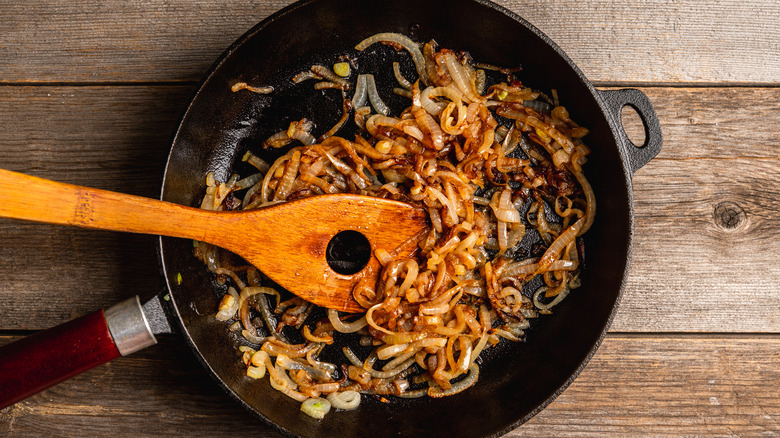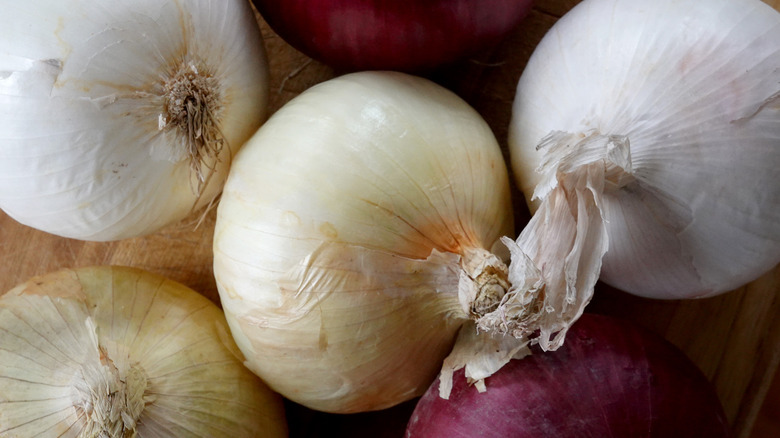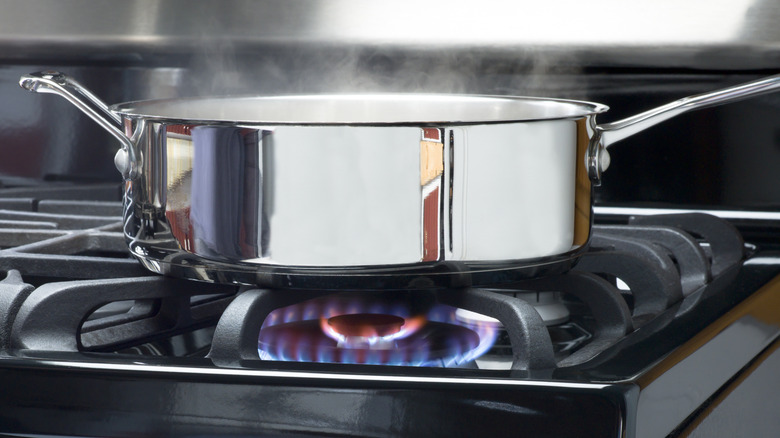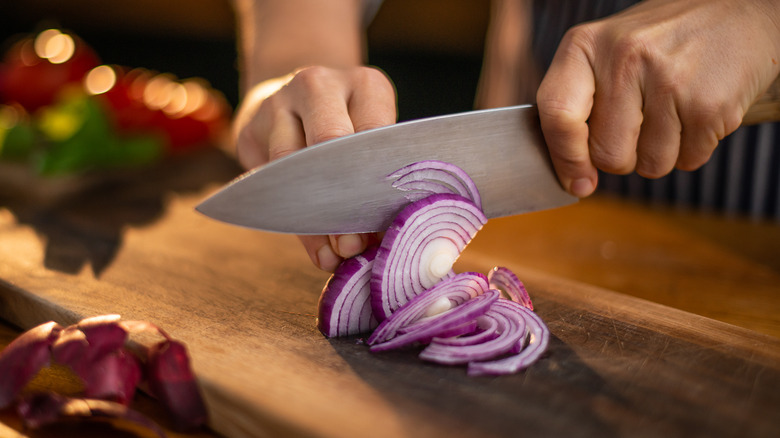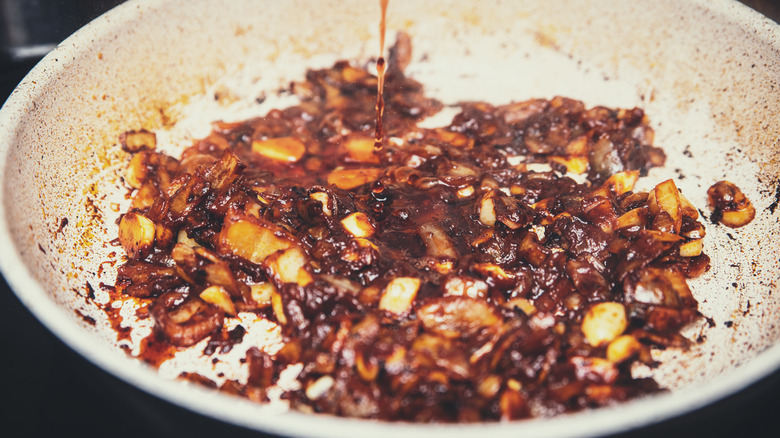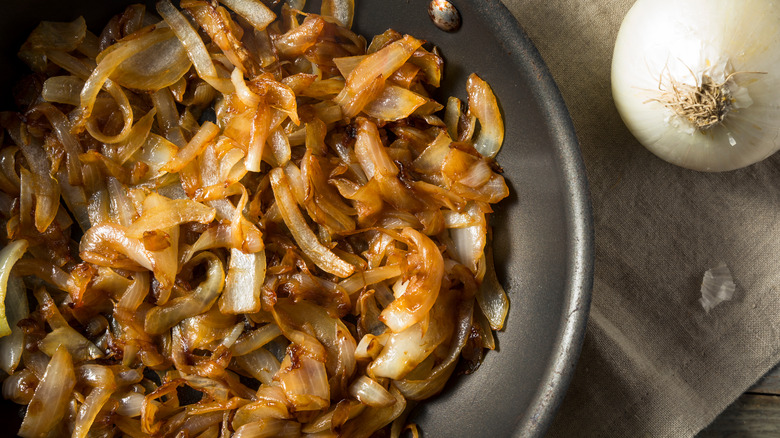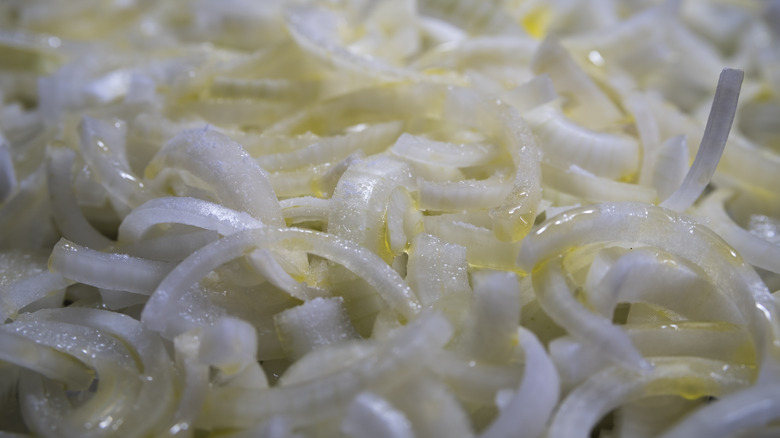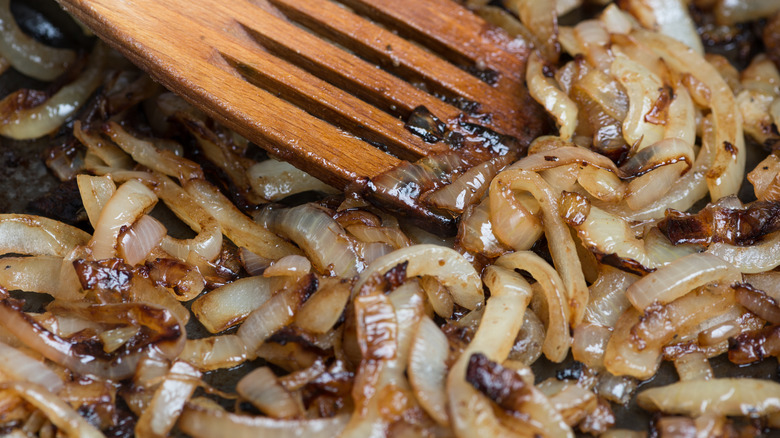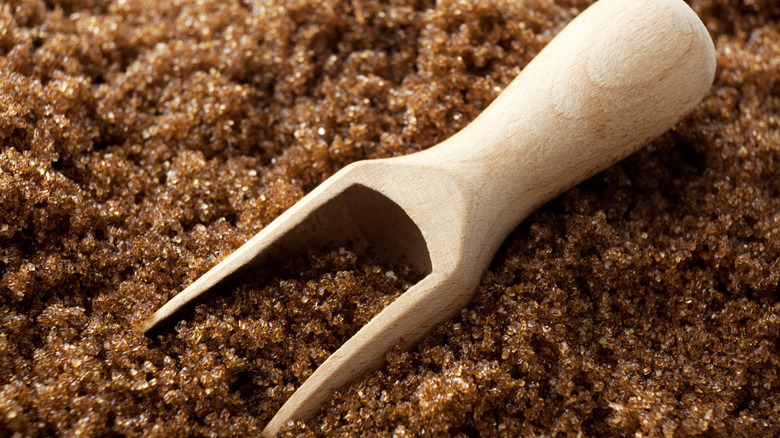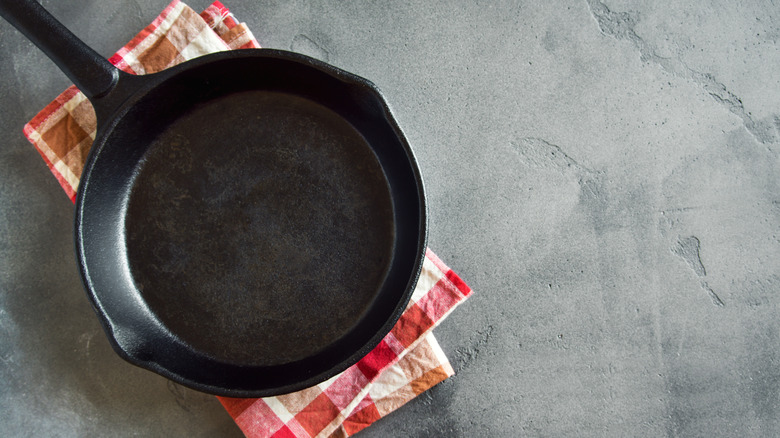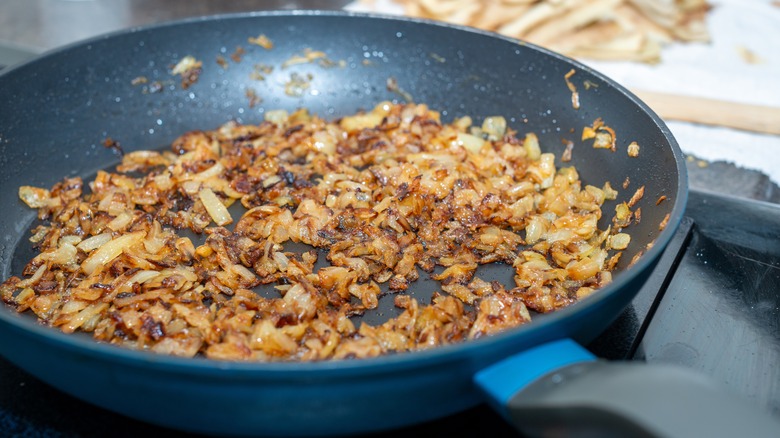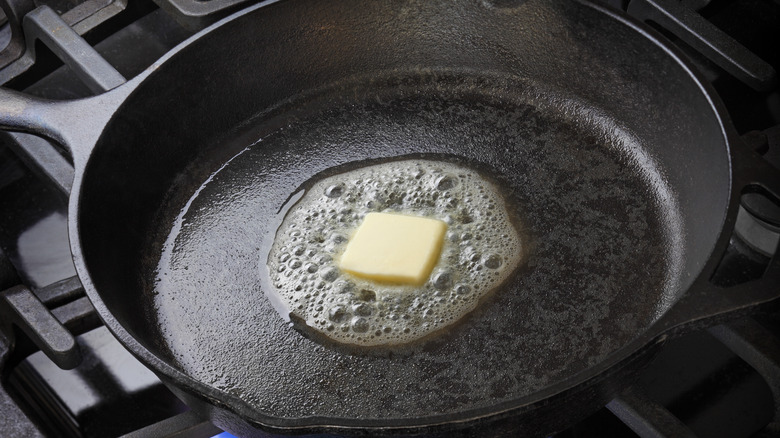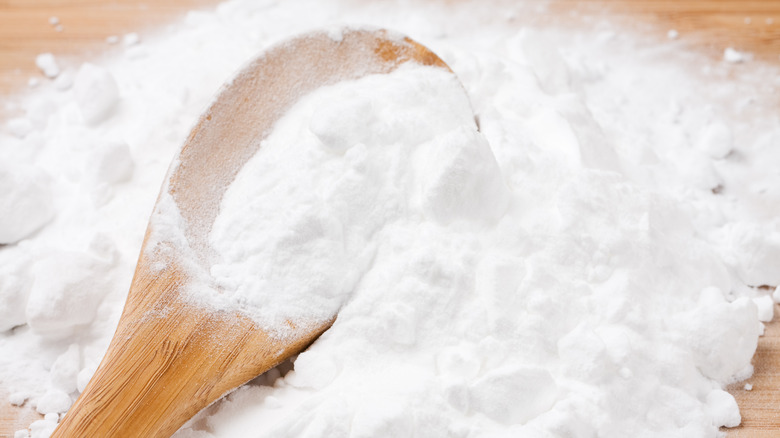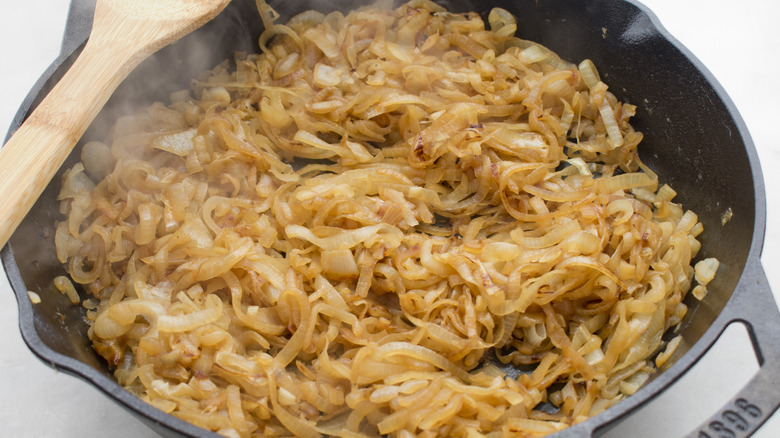13 Mistakes Everyone Makes When Caramelizing Onions
If you're not caramelizing your onions regularly, it's time to start. Caramelizing onions harnesses the onion's natural sugars to transform their flavor from sharp and peppery to juicy, sweet, and complex. When you heat onions gently over a long period, a chemical process called pyrolysis occurs, which breaks the onion's sugars down into smaller particles, altering their structure, color, and flavor. As a result, the onions turn a dark brown, and their water content reduces, intensifying their flavor notes and giving them a whole new role in recipes, allowing you to add a deep sweetness to everything from hummus to pizza and serving as one of the best toppings out there for both meat and vegetable-based dishes.
Caramelizing onions, however, has long been seen as something that only pro chefs can nail — and this isn't the case. Anyone with a pan and an onion can produce premium caramelization with a little patience and a few skills. Where people usually fall over, though, in a few key places, causing them to end up with fried, burnt, or undercooked onions instead of a jammy tangle of caramelized joy. We're about to put an end to all of those stumbling blocks.
1. Picking the wrong type of onion
To make caramelized onions, you first obviously need some onions. However, the specific type of onions you choose can have a direct effect on your result. While you can technically caramelize any type of onion, certain types are far better suited to the cooking process, with yellow onions arguably offering the best flavor profile. Yellow onions, or Spanish onions, tend to retain a little savoriness when caramelized, which is perfect for offering complexity and making sure that the onions don't become too one-note or sugary.
Other onions with higher sugar content, like Vidalia onions, can also be good for caramelizing, thanks to their innate sweetness. If you use them, though, just make sure that you like your caramelized onions to be extra-sweet due to the abundance of sugar molecules present. Red and white onions, shallots, and even spring onions can also be caramelized, with all of them providing a different flavor balance. You can even combine two or more types of onions and caramelize them together, which can give you even more depth and variety.
2. Using too much heat
The amount of heat you use can make or break your caramelized onions, and one of the main mistakes people make is to just use way too much. When you crank the heat up, though, you'll merely end up frying your onions instead of caramelizing them. It's important to remember that there's a clear distinction between the type of browning that occurs with caramelization, which is thanks to pyrolysis, a process that alters the structure of the onion itself due to its breakdown of sugars, and browning thanks to frying. When you fry onions at a higher heat, you provoke the Maillard reaction, a process that involves food's amino acids, as well as its sugars, to develop flavor.
These two processes are similar but distinct from one another — and crucially, they leave you with a different result. Higher heat and the Maillard reaction will give your onions that umami-rich, fried onion scent and flavor, whereas pyrolysis will produce a soft and sweet end product. For the latter, use very low heat to stop your onions from browning or burning before caramelization occurs. It may take way longer, but it's worth it.
3. Slicing your onions unevenly
There's a lot of debate about how you should slice your onions when you caramelize them and the right thickness to go for. In truth, though, the main thing to watch out for is not the width of your onions but how even they are. Consistency is the most important factor when slicing your onions because you want to ensure that they all cook at the same pace. If your onions are uneven, then they will cook unevenly, and it will leave you with chunks of onion that haven't yet caramelized and other pieces that have broken down into mush.
That's not to say that the thickness of your onions won't have an impact on how they caramelize. If you're working with thin slices, they will naturally caramelize more quickly. Thick onions, on the other hand, take more time but may be easier to maneuver and work within your pan. You can also chop onions in any style you like, with diced caramelizing just as well as sliced ones, although slices are way more traditional and offer more for your fork to work with.
4. Forgetting to deglaze your pan
Caramelizing onions isn't just about stirring; it's also about deglazing. Deglazing, which involves adding liquid to a cooking pan to shift the fond, the brown layer of food that develops on the bottom surface of the metal, is a must for extracting maximum taste. "[Deglazing] allows you to harness all of that extra flavor that you would otherwise scrub off and pour down the sink," advises the Institute of Culinary Education's lead chef for Online Culinary Arts & Food Operations Shawn Matijevich, per The Kitchn.
This is particularly important when caramelizing onions because the cooking process is so long, which gives fond more opportunity to develop. If you're not deglazing your pan at the end, you're not just losing all of that beautiful flavor, but you may also lose some of the onion parts that have adhered themselves to the bottom. Water is the easiest liquid to use, but in truth, you can throw in pretty much anything you like to add extra flavor. Chicken or beef broth will give your onions savory and salty notes, while vinegar or wine will imbue them with some acidity that can be useful to cut through their sweetness. Only add a little liquid to deglaze, though, to avoid flooding your onions and ensure that it evaporates readily.
5. Not giving yourself enough time
Caramelized onions don't take much, but what they do take is patience. Time is one of the most important factors in successfully caramelizing onions, partly because for the pyrolysis process to occur and the natural sugars in the vegetable to break down, the water content in them has to shift and evaporate. To do this without burning the onions, the pan has to be heated very gently and slowly, or they'll fry instead of caramelize.
Therefore, if you see a recipe for caramelized onions that says it will take 10-15 minutes, run for the hills — it takes way longer than that. Cooking maestro Julia Childs, for instance, designated in her French onion soup recipe that the caramelization process takes around 35 to 40 minutes in total. Things may take even longer, too, if you're working with especially thick slices of onion. You can certainly aid up the caramelization process in a few ways by adding extra ingredients like sugar or baking soda, but these won't reduce the amount of time it takes significantly.
6. Putting too many onions in your pan
Because caramelized onions take so long to make, a lot of people attempt to do it in batches, loading up their pan with as many sliced onions as possible to maximize the cooking time. While this is a logical move, it's not the best one to make. The caramelization process involves evaporating your onions' water content so that their sugars can start to convert. Overcrowding your pan, though, makes this evaporation more difficult, which leaves your pan swimming in onion-scented water and preventing your onions from turning brown and sweet.
Adding too many onions can also make them harder to stir, which can affect the evenness of your heat distribution and prevent everything from caramelizing at the same rate. Therefore, it's best to try to keep your quantities moderate. The good news is that you can use more onions than you would do if you were trying to fry them or turn them crispy, but you should still aim for no more than two large onions for a 12-inch pan. If you're trying to make loads in one go, it's usually better to use several different pans or cook them in stages.
7. Not adding salt
To caramelize onions, you need to get rid of a lot of pesky water first. Trying to do that merely by heating them, though, will leave you waiting a while. That's why you should always add salt at the beginning of your cooking process, says the Williamsburg Hotel's executive chef Nicolas Caicedo to SELF. Caicedo explains that salt helps the onions to release their natural juices more quickly, which occurs thanks to the process of osmosis, where the moisture inside them works its way to the salt on the outside. As the water is then outside the onion instead of inside, it can be evaporated more quickly.
You should always be sparing with your salt, though. While a little can be helpful for evaporation and also give the onions' sweetness a counterbalance, adding too much can completely ruin their flavor. A pinch or two will normally be enough to activate the osmosis process. If you find that it doesn't help, feel free to add a little more, but give the salt time to do its thing. Remember, you can always add more salt for flavor at the end, but you can't take it out.
8. Forgetting to use sugar
Caramelized onions are renowned for their sweetness — and because that sweetness comes from the vegetable's natural sugars itself, surely it doesn't need more sugar, right? Wrong. Although you can technically make caramelized onions without any extra sugar, adding a little in can easily improve your recipe in a multitude of ways, most notably in how long they take. Throwing in a teaspoon of brown sugar can hasten the caramelization process, encouraging the onions to convert and brown quickly. Furthermore, a little brown sugar can add even more depth to the onions' flavor, with its caramelized, nutty taste pairing effortlessly with the briny-sweet vegetable.
Adding brown sugar can also be a good option for onions that may not have as high of a natural sugar content to encourage them to caramelize more easily. However, you should always be sparing with how much you add. It's easy to underestimate exactly how sweet onions get when they caramelize, and putting in too much sugar may tip them over the edge. You're not trying to make a jelly or a jam here. Remember, this is a food item that should still have a distinctly savory edge to it.
9. Using the wrong type of skillet
The pan you choose may affect your caramelized onions significantly. When caramelizing onions, there's sometimes a temptation to pick a high-sided pan, partly because it stops all of your onion pieces from tumbling over the edge and onto your stove. However, opting for a deep pan can trap the moisture you're trying to evaporate to produce caramelization and make your onions steam instead. High-sided pans may also offer less surface area for your onions to heat on, which is essential for them to caramelize.
As such, it's always best to go with a wide-bottomed skillet with plenty of surface area. You should also think about the material your pan is made from. Cast-iron or stainless steel pans tend to offer the best heat retention and distribution, which is useful for making sure that every piece of onion in your pan stays warm. Although nonstick pans might seem sensible to cut down on clean-up time, they also don't give you that delicious fond on the bottom, which adds so much flavor once it's been deglazed.
10. Stirring them too often
When it comes to caramelized onions, you need to exercise restraint — both in avoiding turning the heat up too much and in avoiding stirring them constantly. It might not seem like such an issue to stir your onions, but when you do so, you alter their contact with the hot pan. It's this direct contact and heat that produces caramelization so effectively, and if you're diffusing that by stirring them all the time, things will take longer and turn out worse.
So, once you add your onions to the pan, leave them alone for at least 10 minutes. This will allow them to come up to temperature and begin the cooking process. Once you've stirred them, then leave them alone again, aiming to stir every 10 minutes or so until they're done. Don't be frightened if they start to stick on the bottom — you can dislodge them with a little bit of water. Remember that this will all add great flavor, too, and because the heat is low, they won't burn.
11. Only using butter
A little bit of fat is helpful for caramelizing onions, and a lot of people opt for butter. On the surface, it makes sense: Butter provides a deliciously creamy flavor to onions, with that same creaminess informing their eventual texture. Using butter and butter alone, though, is tricky when it comes to caramelizing onions because of its low smoke point. Butter burns at way lower temperatures than other fats, even at the low temperatures that you'll be using to caramelize your alliums. This burning brings two problems, the first being that it can make your onions taste gross, and the second being that it can make them look cooked, browned, and finished before they're done.
The best thing to do is to cut your butter with another fat that has a higher smoke point, like vegetable oil. This will improve the cooking process while also giving your onions some of that buttery flavor. Go for a 50:50 ratio of butter to oil for the best results. For each large onion, you'll probably want one tablespoon of fat total, which should be enough to coat each piece and stop it from sticking to the pan, as well as give enough flavor.
12. Forgetting the secret ingredient
While purists may swear by using just a pan, some onions, and a little fat to caramelize their product, other folks know when to accept help when it's out there. That help comes in the form of baking soda. Baking soda can have a powerful effect on the pH level of your onions, even in tiny quantities, and it's the pH level that partly dictates how quickly they caramelize. By raising the onion's pH levels, they go brown and soften quicker, turning what can be an hour-long job into a plate of caramelized onions in just 15 minutes.
Adding a pinch of baking soda per pound of onions can be a nifty trick when you need to speed things up, but keep in mind that it does produce a slightly different result. Your onions will turn out way softer than if you caramelize them without the soda and will have way more of a jammy consistency. They can also tend to turn out slightly more orange instead of brown. Flavor-wise, though, you can't taste the baking soda at all, and if you're looking for a spreadable caramelized result in a jiffy, this hack's for you.
13. Over-caramelizing your onions
It's not a secret that caramelizing onions takes time, but don't leave your pan going all day. There is such a thing as over-caramelizing your onions, which way too many people do, leaving them on the stove for too long so they reduce to mush. You need to keep in mind that caramelized onions need to retain some of their texture, and by cooking them for too long, you end up with, essentially, an onion jam or thick sauce.
You should always take your onions off the stove when they're deep brown and jammy but still in individual pieces and not a gelatinous mass. Remember that adding too much deglazing liquid can also cause them to become mushy, especially if you then try to cook it off, which will further deconstruct your onions. If you like caramelized onions with a little more bite, slice them slightly thicker, as thin slices or small diced pieces will be way more prone to breaking down too much and turning soft.
